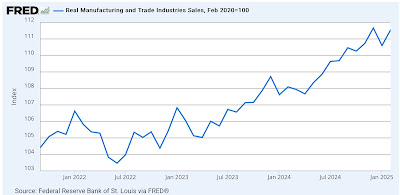- by New Deal democrat
The big headline takeaway in today’s advance report on Q1 GDP, besides the -0.3% number, was that imports deducted about -5.0% on an annualized basis, overcoming a fairly strong 3.0% contribution in real terms from consumer spending. Here’s the breakout graph from the BEA:
The graph tells the story; both real consumption and investment together increased almost 5% in real terms annualized, but were overbalanced by an even bigger surge in imports (counted as a negative). In other words, it is compelling evidence for massive front-running of tariffs by both producers and consumers. That contributed to the on-trend increase in real final sales to domestic purchasers, the typical core of the economy:
But as usual, my focus is on the leading indicators contained in the report. And this quarter, they were both sharply negative.
The first of the two is residential fixed investment, particularly as a percentage of GDP. This is a proxy for housing.
In nominal terms, residential fixed investment rose 1.3%. Because the GDP deflator increased 0.9% quarterly, it rose 0.4% in real terms. Whether measuring in nominal or real terms, it rose as a share of GDP:
Nevertheless both remain below their recent peaks in Q1 2024. Still, the general trend of the past several years has been a slow increase. Since on average this number peaks 7 quarters before the onset of a recession, in normal times it would be consistent both with a recession starting in the second half of this year, but also if there were to be a further increase above Q1 2024 levels, a continued expansion throughout.
The second long leading indicator is corporate profits, which won’t be reported for another month. Fortunately there is a very good proxy in the form of proprietors’ income, which tends to peak simultaneously with or one quarter later than corporate profits.
In Q1, nominally proprietors’ income rose 1.2%. Since the deflator increased 0.9% on a quarterly basis, translated into real terms it increased by a rounded 0.3%:
In ordinary times, the bottom line would be that, in Q1 both long leading economic indicators contained in the GDP report indicated continued expansion through the rest of this year. Unfortunately, because of the tariff situation, these are not ordinary times, and indeed much of this report, both in positive and negative terms, was confounded by likely massive front-running of same.




























